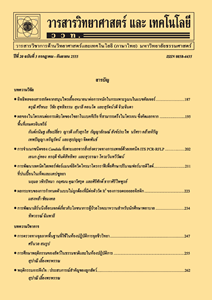Callus Induction and Antioxidant Contents in Callus Cultures of Thunbergia laurifolia
Main Article Content
Abstract
Thunbergia laurifolia Lindl. is a medicinal plant which its flowers and leaves contain high antioxidants and use to detoxify poison from human body. Callus culture is one of plant tissue culture techniques that benefits to produce secondary metabolites of medicinal plants. Therefore, the objectives of this study were to investigate the effect of 2,4-D, NAA and BA at various concentrations for callus induction from in vitro leaf explants and antioxidant contents of T. luarifolia callus at different culture periods comparing to in vitro regenerated shoot and in vivo leaf. For callus induction, in vitro leaf explants were cultured on MS medium supplemented with 0.5-1.0 mg/L 2,4-D and NAA only or in combination with 0.5 mg/L BA comparing to MS medium without plant growth regulator (control treatment) for 6 weeks. The results showed that callus induction occurred on all test media except control treatment. MS medium supplemented with 0.5-1.0 mg/L NAA in combination with 0.5 mg/L BA, and MS medium supplemented with 0.5 mg/L 2,4-D in combination with 0.5 mg/L BA gave the highest callus fresh and dry weight. Antioxidant contents of 5, 6, and 7 week-old-calli cultured on MS medium supplemented with 0.5 mg/L NAA and 0.5 mg/L BA were investigated comparing to in vitro regenerated shoot and in vivo mature leaf. It was found that the four, five and six-week-old-calli and in vitro shoot exhibited greater total phenolic contents (64.41±1.29 - 67.29±3.17 mg GAE/g dry extract), flavonoid contents (44.38±11.61 - 54.60±9.22 mg CE/g dry extract), and DPPH radical scavenging activities (with the EC50 values in a range of 15.93±1.33 - 18.99±0.86 µg/mL), than those of in vivo mature leaf.
Article Details
References
Chan, E.W.C., Eng, S.Y., Tan, Y.P. and Wong, Z.C., 2011, Phytochemistry and pharmacological properties of Thunbergia laurifolia: A review, Phcog. J. 3: 1-6.
Thongsaard, W. and Marsden, C.A., 2002, A herbal medicine used in the treatment of addiction mimics the action of amphetamine on in vitro rats trial dopamine release, Neurosci. Lett. 329: 129-132.
Oonsivilai, R., Ferruzzi, M.G. and Ningsanond, S., 2008, Antioxidant activity and cytotoxicity of Rang Chuet (Thunbergia laurifolia Lindl.) extracts, Asian J. Food Ag-Ind. 1: 116-28.
Jirakiattikul, Y., Rithichai, P., Patchaika, S. and Songserm, K., 2018, In vitro propagation of Thunbergia laurifolia Lindl., Songklanakarin J. Plant Sci. 5: 18-24. (in Thai)
Ramachandra Rao, S. and Ravishankar, G. A., 2002, Plant cell cultures: Chemical factories of secondary metabolites, Biotechnol. Adv. 20: 101-153.
Phillips, G.C. and Garda, M., 2019, Plant tissue culture media and practices: An overview, In vitro Cell. Develop. Biol. Plant 55: 242-257.
Kumar, M. and Nandi, S., 2014, Analysis of organogenic callus from internode explants of Asteracantha longifolia Nees, J. Genet. Eng. Biotechnol. 13: 31-37.
Yaacob, J., Taha, R., Jaafar, N., Hasni, Z., Elias, H. and Mohamed, N., 2013, Callus induction, plant regeneration and somaclonal variation in in vivo and in vitro grown white shrimp plant (Justicia betonica Linn.), Aust. J. Crop Sci. 7: 281-288.
Banthorpe, B.V., 1994, Secondary metabolism in plant tissue culture: Scope and limitations, Nat. Prod. Rep. 11: 303-328.
Boonyuen, T., Jirakiattikul, Y., Rithichai, P., Ruangnoo, S. and Itharat, A., 2014, Dioscorealide B content of in vitro Khao-Yen-Tai (Dioscorea membranacea Pierre ex Prain & Burkill) shoots at different culture periods, Khon Kaen Agric. J. 42(Suppl. 3): 306-310. (in Thai)
Chen, H. and Chen, F., 2000, Effects of yeast elicitor on the growth and secondary metabolism of a high-tansshinone-producing line of the Ti transformed Salvia miltiorrhiza cells in suspension culture, Proc. Biochem. 35: 837-840.
De, D. and De, B., 2005, Elicitation of diosgenin production in Dioscorea floribunda by ethylene-generating agent, Fitoterapia 76: 153-156.
Jirapongpattana, R., Jirakiattikul, Y., Rithichai, P., Ruangnoo, S. and Itharat, A., 2016, Secondary metabolite contents of in vitro Hua-Khao-Yen (Dioscorea birmanica Prain & Burkill) shoots at different culture periods, Thai Sci. Technol. J. 24(1): 40-48. (in Thai)
Jaiarree, N., 2010, Biological Activities of Dioscorea birmanica Prain & Burkill Extract and Its Active Ingredients, Doctoral Disseration, Faculty of Medicine, Thammasat University, Pathum Thani.
Folin, O. and Ciocalteu, V., 1927, On tyrosine and tryptophan determination in proteins, J. Bio. Chem. 27: 627-650.
Zhu. H., Wang. Y., Liu, Y., Xia, Y. and Tang, T., 2010, Analysis of flavonoids in Portulaca oleracea L. by UV-Vis spectrophotometry with comparative study on different extraction technologies, Food Anal. Methods 3: 90-97.
Yamasaki, K., Hashimoto, A., Kokusenya, Y., Miyamoto, T. and Sato, T., 1994, Electrochemical method for estimating the antioxidantive effect of methanol extracts of crude drugs, Chem. Pharm. Bull. 42: 1663-1665.
Autaijamsripon, J., Jirakiattikul, Y., Rithichai, P. and Itharat, A., 2017, Effect of culture periods on secondary metabolite contents and antioxidant activity of in vitro Bacopa monnieri shoots, Thai Sci. Technol. J. 25(3): 443-452. (in Thai)
Razdan, M.K., 2002, Introduction to Plant Tissue Culture, 2nd Ed., Science Publishers, Enfield. 375 p.
Lashin, I.I. and Elhaw, M.H., 2016, Evaluation of secondary metabolites in callus and tissue of Physalis peruviana, IJMB 6: 10-17.
Shilpashree, H.P. and Ravishankar, R., 2009, In vitro plant regeneration and accumulation of flavonoids in Hypericum mysorense, Int. J. Integr. Biol. 8: 43-49.


